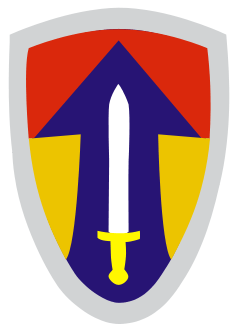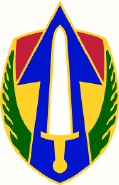II Field Force, Vietnam
| II Field Force, Vietnam | |
|---|---|
 II Field Force, Vietnam shoulder sleeve insignia | |
| Active | 1966–1971 |
| Country |
|
| Allegiance |
|
| Type | Command |
| Size | Corps |
| Part of |
|
| Headquarters | Long Binh |
| Engagements | Vietnam War |
| Commanders | |
| Notable commanders | Julian Ewell |
| Insignia | |
| Distinctive unit insignia |
 |
II Field Force, Vietnam was a United States Army Corps-level command during the Vietnam War.
Activated on 15 March 1966, it became the largest corps command in Vietnam and one of the largest in Army history. II Field Force was assigned the lineage of the XXII Corps, a World War II corps in the European Theater of Operations. II Field Force was a component of U.S. Military Assistance Command Vietnam (MACV) and had its headquarters in Long Binh.
Area of Responsibility
II Field Force's area of responsibility was III Corps Tactical Zone, later renamed Military Region 3, which comprised eleven provinces surrounding Saigon. This was designed to mimic the ARVN III Corps region. II Field Force controlled units participating in the 1968 Tet Offensive and the 1970 Cambodian Incursion.
Units Assigned
At various times during the Vietnam War, II FFV controlled the following units:
- 1st Infantry Division
- 9th Infantry Division
- 25th Infantry Division
- 101st Airborne Division
- 1st Cavalry Division (Airmobile)
- 3rd Brigade 82nd Airborne Division
- 3rd Brigade, 4th Infantry Division
- 173rd Airborne Brigade
- 196th Light Infantry Brigade
- 199th Light Infantry Brigade
- 11th Armored Cavalry Regiment
- 12th Combat Aviation Group
- 23rd Artillery Group
- 54th Artillery Group
- 53rd Signal Battalion
- 1st Australian Task Force
- Royal Thai Army Volunteer Force
II Field Force Vietnam Headquarters Elements:
- Company F (Long Range Patrol) 51st Infantry (Airborne)
- Company D (Ranger) 151st Infantry (Airborne) Indiana Army National Guard
- Company D (Ranger) 75th Infantry (Airborne)
- HHB, II FFV Artillery
- 303rd ASA Battalion
- 6th Psychological Operations Battalion
- 2nd Civil Affairs Company
- 552 Military Police Company
- 9th Transportation Company
- 44th Army Postal Company
- 29th Chemical Detachment
- 61st Medical Detachment (MB)
- 7th Military History Detachment
- 219th Military Intelligence Detachment
- 14th Public Information Detachment
- 16th Public Information Detachment
Inactivation
II Field Force was de-activated on 2 May 1971, during the withdrawal of U.S. ground combat forces from Vietnam, with its assets providing the basis for its successor, Third Regional Assistance Command (TRAC).
Commanders
- Lieutenant General Jonathan O. Seaman (March 1966 – March 1967)
- Lieutenant General Bruce Palmer, Jr. (March – July 1967)
- Major General Frederick C. Weyand (July 1967 – August 1968)
- Major General Walter T. Kerwin, Jr. (August 1968 – April 1969)
- Lieutenant General Julian J. Ewell (April 1969 – April 1970)
- Lieutenant General Michael S. Davison (April 1970 – May 1971)[1]
Notes
- ↑ Leepson & Hannaford 1999, p. 469.
References
- Leepson, Marc; Hannaford, Helen (1999). Webster's New World Dictionary of the Vietnam War. New York: Simon & Schuster. ISBN 0028627466.
- Stanton, Shelby, Vietnam Order of Battle, ISBN 0-89193-700-5